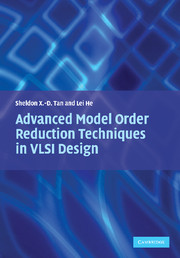Book contents
- Frontmatter
- Contents
- Figures
- Tables
- Foreword
- Acknowledgments
- 1 Introduction
- 2 Projection-based model order reduction algorithms
- 3 Truncated balanced realization methods for MOR
- 4 Passive balanced truncation of linear systems in descriptor form
- 5 Passive hierarchical model order reduction
- 6 Terminal reduction of linear dynamic circuits
- 7 Vector-potential equivalent circuit for inductance modeling
- 8 Structure-preserving model order reduction
- 9 Block structure-preserving reduction for RLCK circuits
- 10 Model optimization and passivity enforcement
- 11 General multi-port circuit realization
- 12 Reduction for multi-terminal interconnect circuits
- 13 Passive modeling by signal waveform shaping
- References
- Index
9 - Block structure-preserving reduction for RLCK circuits
Published online by Cambridge University Press: 19 January 2010
- Frontmatter
- Contents
- Figures
- Tables
- Foreword
- Acknowledgments
- 1 Introduction
- 2 Projection-based model order reduction algorithms
- 3 Truncated balanced realization methods for MOR
- 4 Passive balanced truncation of linear systems in descriptor form
- 5 Passive hierarchical model order reduction
- 6 Terminal reduction of linear dynamic circuits
- 7 Vector-potential equivalent circuit for inductance modeling
- 8 Structure-preserving model order reduction
- 9 Block structure-preserving reduction for RLCK circuits
- 10 Model optimization and passivity enforcement
- 11 General multi-port circuit realization
- 12 Reduction for multi-terminal interconnect circuits
- 13 Passive modeling by signal waveform shaping
- References
- Index
Summary
Introduction
In the chapter, we introduce another structure-preserving model order reduction method, which extends the SPRIM method [37] to more general block forms while the 2q moment-matching property is still preserved. The SPRIM method partitions the state matrix in the MNA (modified nodal analysis) form into natural 2 × 2 block matrices, i.e., conductance, capacitance, inductance, and adjacent matrices. Accordingly, the projection matrix is partitioned. As a result, SPRIM matches twice the moments of the models by using the projection matrix given by PRIMA. The reduced models also preserve the structural properties of the original models like symmetry (reciprocity). This idea has been extended to deal with more partitions by block structure-preserving model order reduction (BSMOR) [136], as shown in Chapter 8 to further exploit the regularity of the many parasitic networks. It was shown that by introducing more partitions, more poles are matched and this leads to more accurate order-reduced models [138].
However, the BSMOR method simply introduce more partitions or blocks; it does not truly preserve the circuit structures for general RLCK circuits for different input sources (voltages or currents). The reduced model does not match the 2q moments of the original models, as SPRIM does.
In this chapter, we first show theoretically that structure-preserving model order reduction can be applied to RLCK admittance networks, which are driven by voltage sources and requires partitioning of the original MNA circuit matrix into 2 × 2 block matrices.
- Type
- Chapter
- Information
- Advanced Model Order Reduction Techniques in VLSI Design , pp. 158 - 171Publisher: Cambridge University PressPrint publication year: 2007



